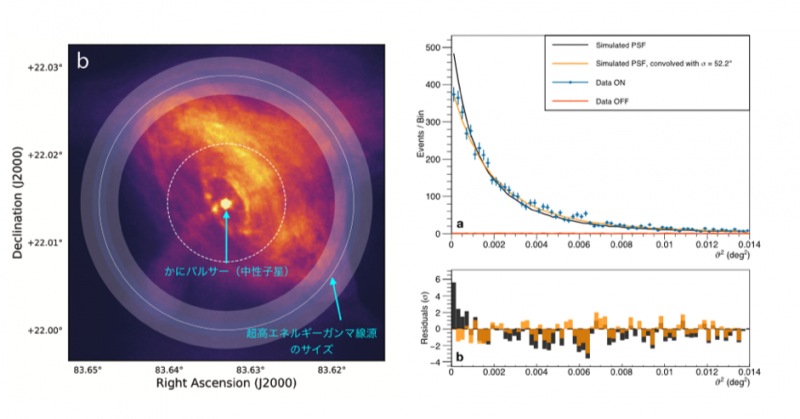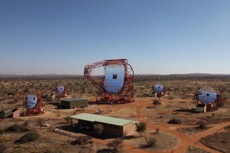November 15, 2019
Kavli Institute for the Physics and Mathematics of the Universe (Kavli IPMU)
 In a world first, an international collaboration of researchers has been able to identify the region in the Crab Nebula where very high-energy gamma rays are emitted, reports a recent study in Nature Astronomy.
In a world first, an international collaboration of researchers has been able to identify the region in the Crab Nebula where very high-energy gamma rays are emitted, reports a recent study in Nature Astronomy.
In 1054, astronomers recorded seeing a supernova explosion, which later transformed into the Crab Nebula. The supernova remnant is powered by a pulsar; a highly magnetized, rotating neutron star, which produces a pulsar wind nebular spanning 10 light-years across. The wind is filled with electrons and positrons. These particles produce very high-energy gamma rays, which until now no one knew which region they were being emitted from.
The H.E.S.S. (High Energy Stereoscopic System) collaboration set out to be the first to confirm that the Crab nebula has an angular extension at gamma-ray energies, much larger than at X-ray energies. The collaboration involves researchers from 13 countries around the world who use the Imaging Atmospheric Cherenkov Telescopes in Namibia to study gamma rays. The collaboration includes Kavli Institute for the Physics and Mathematics of the Universe Principal Investigator Tadayuki Takahashi, and Rikkyo University Professor Yasunobu Uchiyama.
 The telescopes use Earth’s atmosphere as a giant detector, measuring the energy of incoming gamma rays and pinpointing which direction they came from. However, this requires a precise model of Earth’s atmosphere in order to obtain accurate results. But Earth’s atmosphere is complicated, and easily changes, making accurate analysis challenging.
The telescopes use Earth’s atmosphere as a giant detector, measuring the energy of incoming gamma rays and pinpointing which direction they came from. However, this requires a precise model of Earth’s atmosphere in order to obtain accurate results. But Earth’s atmosphere is complicated, and easily changes, making accurate analysis challenging.
The H.E.S.S. team improved calculation techniques to create a more detailed atmosphere model. By using this improved data science technology to its fullest potential, the researchers were able to calculate the size of the area of very high-energy gamma rays.
They found the very high energy gamma rays being emitted from the Crab Nebula did not originate from a small point, but from a large area of space. That area was found to be larger than what conventional x-ray analyses had observed, but smaller than what had been recorded by infrared analyses.
Their analysis of the high energy particles in the gamma rays will help researchers learn where they are generated from, and how they propagate. The team were able to recreate the results through simulations, proving their calculations were correct.
Details of the study were published on October 28 in Nature Astronomy.
Paper details
Journal: Nature Astronomy
Title: Resolving the Crab pulsar wind nebula at teraelectronvolt energies
Authors: H.E.S.S. Collaboration
(H. Abdalla, F. Aharonian, F. Ait Benkhali, E. O. Angüner, M. Arakawa, C. Arcaro, C. Armand, M. Backes, M. Barnard, Y. Becherini, J. Becker Tjus, D. Berge, K. Bernlöhr, R. Blackwell, M. Böttcher, C. Boisson, J. Bolmont, S. Bonnefoy, P. Bordas, J. Bregeon, F. Brun, P. Brun, M. Bryan, M. Büchele, T. Bulik, T. Bylund, M. Capasso, S. Caroff, A. Carosi, S. Casanova, M. Cerruti, N. Chakraborty, T. Chand, S. Chandra, R. C. G. Chaves, A. Chen, S. Colafrancesco, B. Condon, I. D. Davids, C. Deil, J. Devin, P. deWilt, L. Dirson, A. Djannati-Ataï, A. Dmytriiev, A. Donath, V. Doroshenko, L. O’C. Drury, J. Dyks, K. Egberts, G. Emery, J.-P. Ernenwein, S. Eschbach, S. Fegan, A. Fiasson, G. Fontaine, S. Funk, M. Füßling, S. Gabici, Y. A. Gallant, F. Gaté, G. Giavitto, D. Glawion, J. F. Glicenstein, D. Gottschall, M.-H. Grondin, J. Hahn, M. Haupt, G. Heinzelmann, G. Henri, G. Hermann, J. A. Hinton, W. Hofmann, C. Hoischen, T. L. Holch, M. Holler, D. Horns, D. Huber, H. Iwasaki, A. Jacholkowska, M. Jamrozy, D. Jankowsky, F. Jankowsky, L. Jouvin, I. Jung-Richardt, M. A. Kastendieck, K. Katarzyński, M. Katsuragawa, U. Katz, D. Khangulyan, B. Khélifi, J. King, S. Klepser, W. Kluźniak, Nu. Komin, K. Kosack, M. Kraus, G. Lamanna, J. Lau, J. Lefaucheur, A. Lemière, M. Lemoine-Goumard, J.-P. Lenain, E. Leser, T. Lohse, R. López-Coto, I. Lypova, D. Malyshev, V. Marandon, A. Marcowith, C. Mariaud, G. Martí-Devesa, R. Marx, G. Maurin, P. J. Meintjes, A. M. W. Mitchell, R. Moderski, M. Mohamed, L. Mohrmann, C. Moore, E. Moulin, T. Murach, S. Nakashima, M. de Naurois, H. Ndiyavala, F. Niederwanger, J. Niemiec, L. Oakes, P. O’Brien, H. Odaka, S. Ohm, M. Ostrowski, I. Oya, M. Panter, R. D. Parsons, C. Perennes, P.-O. Petrucci, B. Peyaud, Q. Piel, S. Pita, V. Poireau, A. Priyana Noel, D. A. Prokhorov, H. Prokoph, G. Pühlhofer, M. Punch, A. Quirrenbach, S. Raab, R. Rauth, A. Reimer, O. Reimer, M. Renaud, F. Rieger, L. Rinchiuso, C. Romoli, G. Rowell, B. Rudak, E. Ruiz-Velasco, V. Sahakian, S. Saito, D. A. Sanchez, A. Santangelo, M. Sasaki, R. Schlickeiser, F. Schüssler, A. Schulz, H. Schutte, U. Schwanke, S. Schwemmer, M. Seglar-Arroyo, M. Senniappan, A. S. Seyffert, N. Shafi, I. Shilon, K. Shiningayamwe, R. Simoni, A. Sinha, H. Sol, A. Specovius, M. Spir-Jacob, L. Stawarz, R. Steenkamp, C. Stegmann, C. Steppa, T. Takahashi, J.-P. Tavernet, T. Tavernier, A. M. Taylor, R. Terrier, D. Tiziani, M. Tluczykont, C. Trichard, M. Tsirou, N. Tsuji, R. Tuffs, Y. Uchiyama, D. J. van der Walt, C. van Eldik, C. van Rensburg, B. van Soelen, G. Vasileiadis, J. Veh, C. Venter, P. Vincent, J. Vink, F. Voisin, H. J. Völk, T. Vuillaume, Z. Wadiasingh, S. J. Wagner, R. M. Wagner, R. White, A. Wierzcholska, R. Yang, H. Yoneda, D. Zaborov, M. Zacharias, R. Zanin, A. A. Zdziarski, A. Zech, A. Ziegler, J. Zorn & N. Żywucka)
DOI: https://doi.org/10.1038/s41550-019-0910-0 (Published October 28, 2019)
Media contact
Motoko Kakubayashi
Press officer
Kavli Institute for the Physics and Mathematics of the Universe
University of Tokyo
TEL:+81-04-7136-5980
E-mail:press_at_ipmu.jp
* please change _at_ to @






